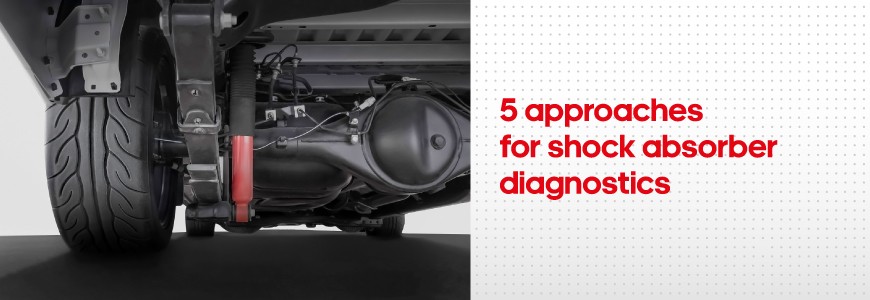
The shock absorbers– the integral part of a car, and if they wear and fail the driving comfort and the safety suffer much.
Often, the shock absorbers with defects cause the sooner wear of other parts of the drivetrain such as hub bearings, ball joints as well as the wheel discs and the tyres. Besides, a car body geometry transforms if a car runs the bad roads with failed shock absorbers.
5 approaches for shock absorber diagnostics
To check the shock absorber performance capacity, you could use the following efficient methods:
First method: visual inspection
Quick and costless, you could check if the shock absorber has:
- oil leakage;
- corrosion;
- mechanical damages;
- dust boost wear.
If you noticed the oil leakage, it means that the shock absorber integrity has been broken due to the natural wear or the extreme impacts. Besides, the low cost shock absorbers can leak. If the road pavement is bad, a shock absorber may fail up to the end of a season. Once the oil leakage is revealed, the shock absorbers have to be replaced.
The corrosion on the body surface or on the rod – trigger for the detailed diagnostics of shock absorbers. The corrosion may damage the shock absorber integrity.
The rubber flexible dust boost protects the shock absorber, and if this component is damaged, the moisture and dirt will get to the rod, it results in the sooner wear of shock absorber and causes the corrosion.
During the visual inspection you may notice the shock absorber deflection. If it’s bent, you have to replace the shock absorber.
Second method: bouncetest
A car should be on the even road. Push on the corner of car body so that it goes down and then release it – for each corner. The results can be as follows:
- the body gets back to the initial position at once and remains stationery (the shock absorber is in order);
- the car body keeps bouncing (the shock absorbers have defects)
What are the pitfalls of driving a car with the malfunctioning shock absorbers? When you cross any road unevenness, the shock absorber cannot stabilize the car properly, the wheels lose the grip with road. And a car our-of-control may cause the accident.
Third method: in-motion test
This test can be effected only by the highly experienced drivers and on the secure road section. On the even road, pick up the speed up to 40-50 km/h and turn sharply the steering wheel to the side and back. If the car starts careening when turning and keeps bouncing after getting back to the normal position, - the shock absorbers have defects.
Also, when you drive the uneven road, pay attention to the car behavior: if it bounces all the time, the life span of shock absorbers is over.
When you cross a speed bump and hear the impacts, the shock absorbers weak, the rod beats the car body.
Fourth method: no-equipment diagnostics of shock absorber dismounted from a car
This method is applicable for both new and used shock absorbers. It allows to evaluate the shock absorber resistance power.
The shock absorber should be stretched as much as possible, set it against the solid surface by a rod side. Press the shock absorber sharply until hard stop. If you could it easy and quick, without any resistance – the shock absorber should be replaced.
If the shock absorber is in order, it’s quite difficult to stretch and press it. The rod should move straight, without any deflections.
Fifth method: diagnostics on the test bench
The most reliable and correct approach for shock absorber diagnostics – testing it on the special bench. This method will demonstrate the operating life remained, and if the shock absorber needs to be replaced.
If car runs the uneven roads mostly, you should test the shock absorbers during the routine maintenance.
MSG Equipment offers the special-purpose equipment for the diagnostics of shock absorbers at car service stations and garages – test bench MS1000+. It enables the quick and accurate evaluation of the technical condition of shock absorbers. The test bench determines the repair necessity, controls the repair quality and if shock absorber conforms with the specifications after repair.
Learn more about the special-purpose equipment for the diagnostics and repair of shock absorbers on the website or contact us.



COMMENTS